Abstract
We have used a half-YAC containing the human chromosome 21 long-arm telomere to clone, map, and characterize a new dinucleotide repeat polymorphism (D21S1575) close to 21qter. This marker is < 120 kb from the telomeric (TTAGGG)n sequences and is the most distal highly polymorphic marker on chromosome 21q. This marker has a heterozygosity of 71% because of a variable (TA)n repeat embedded within a long interspersed element (LINE) element. Genotyping of the CEPH families and linkage analysis provided a more accurate determination of the full length of the chromosome 21 genetic map. A highly significant difference was detected between male and female recombination rates in the telomeric region: in the most telomeric 2.3 Mb of chromosome 21q, recombination was only observed in male meioses.
Full text
PDF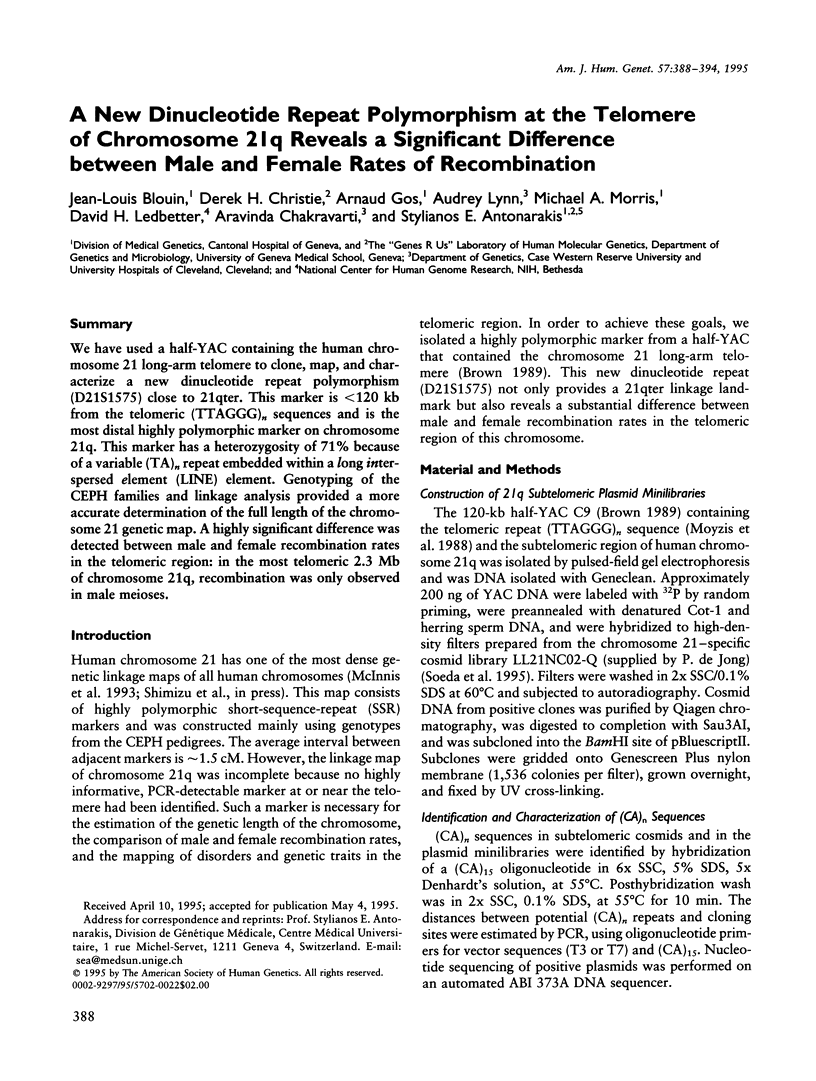
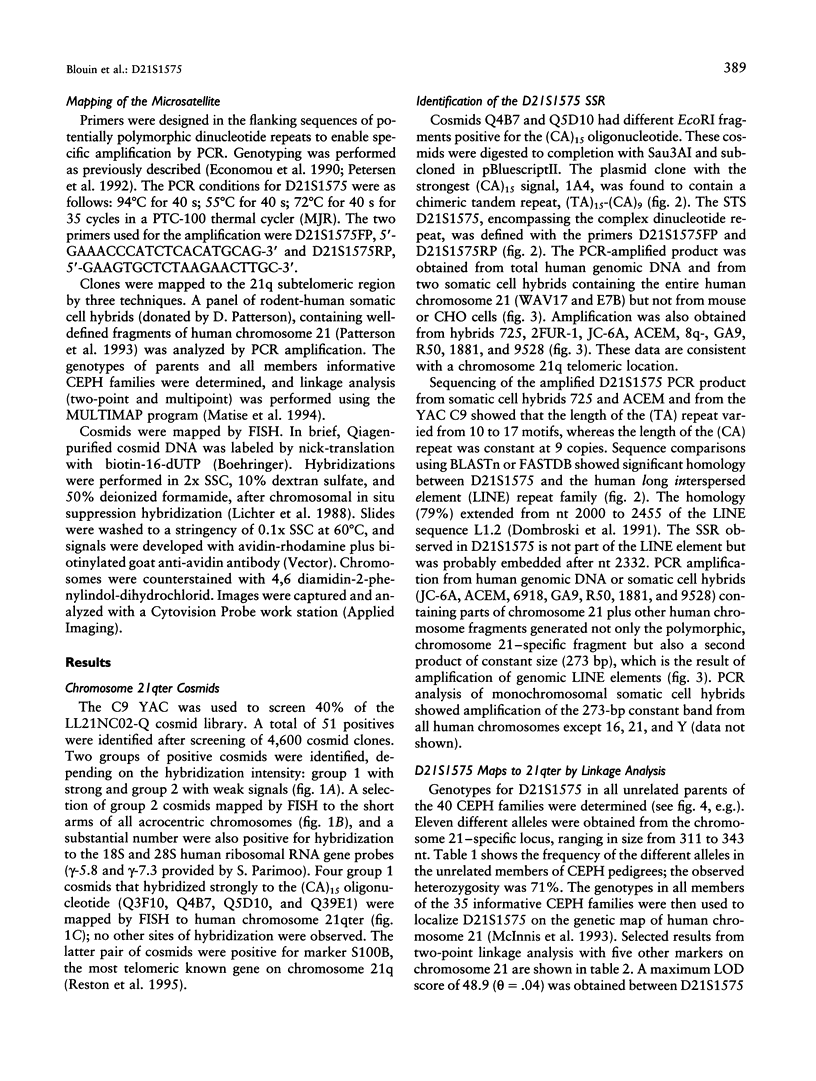
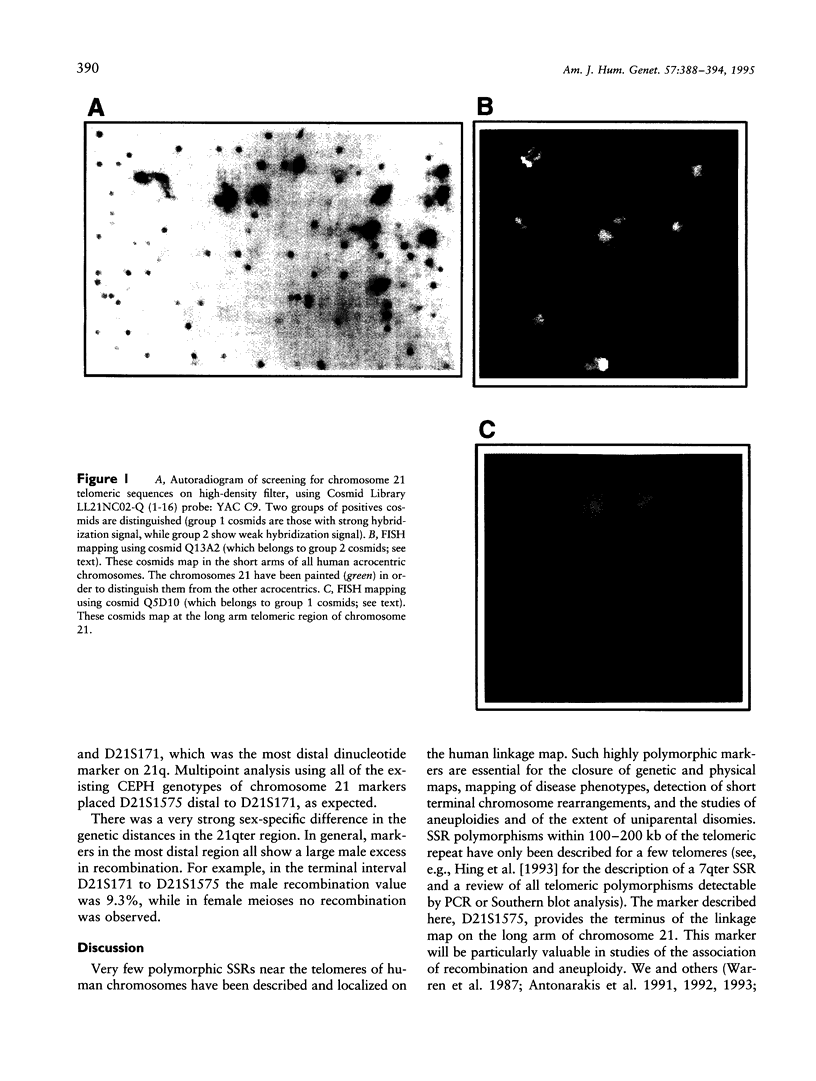
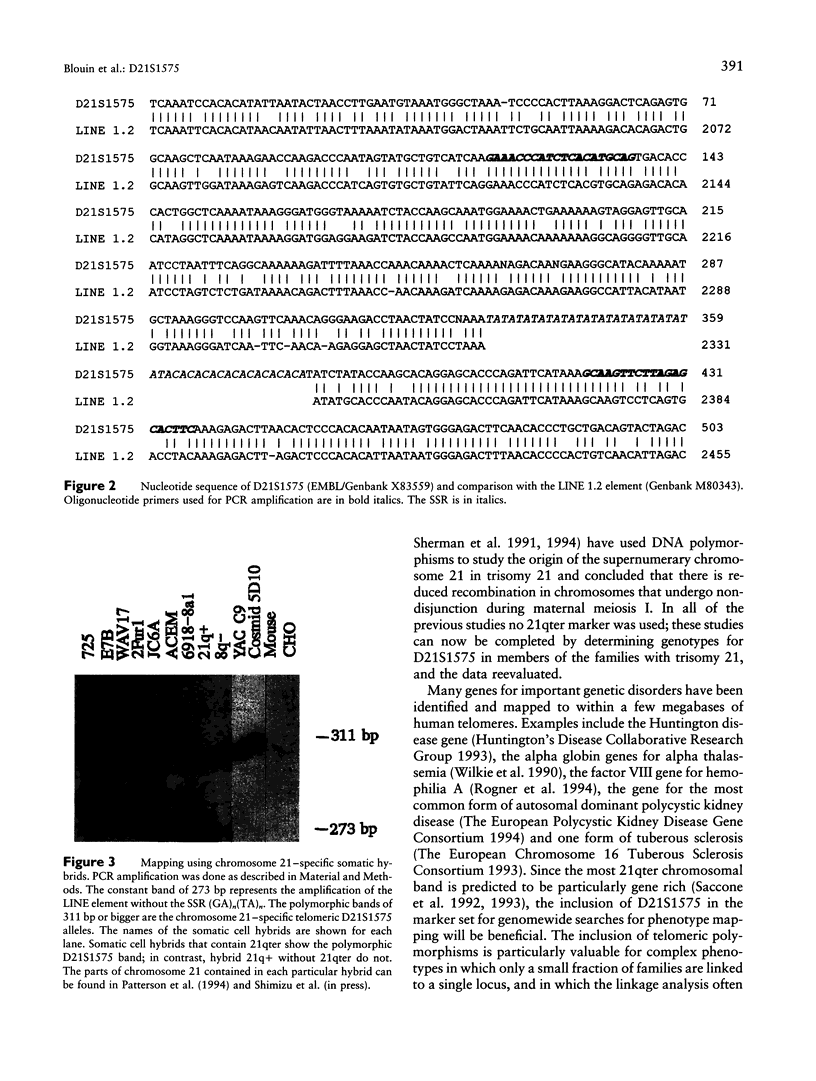
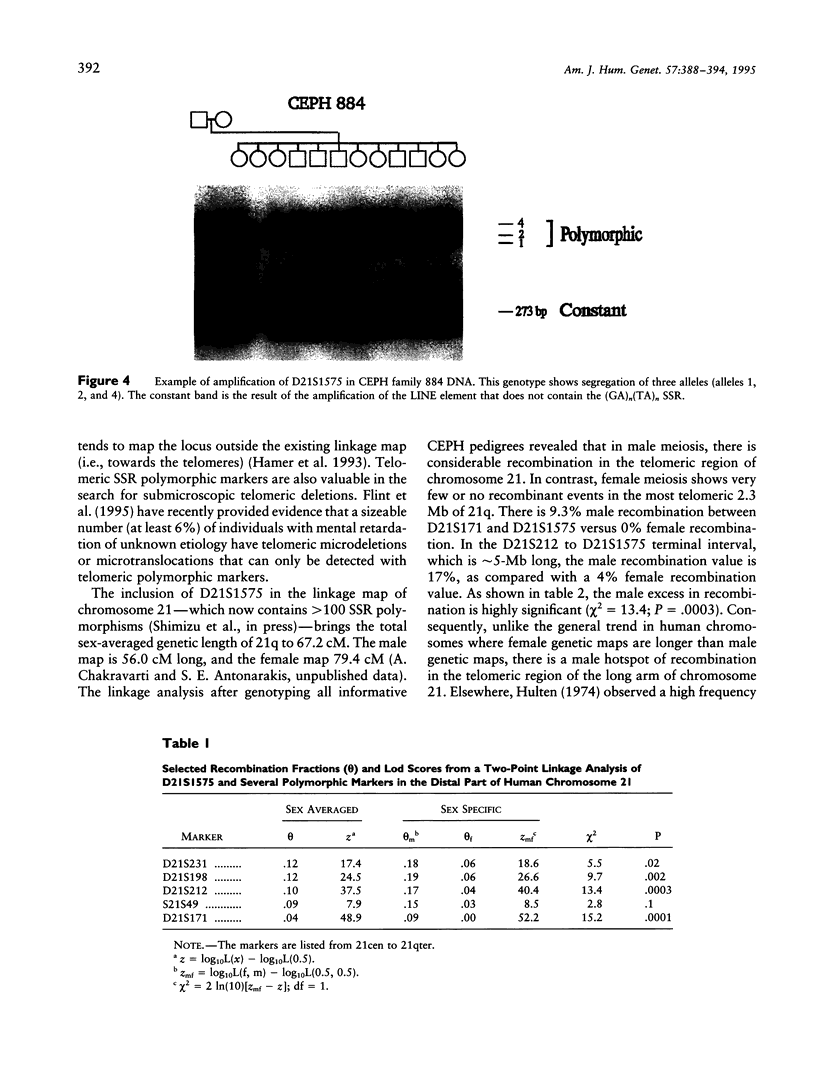
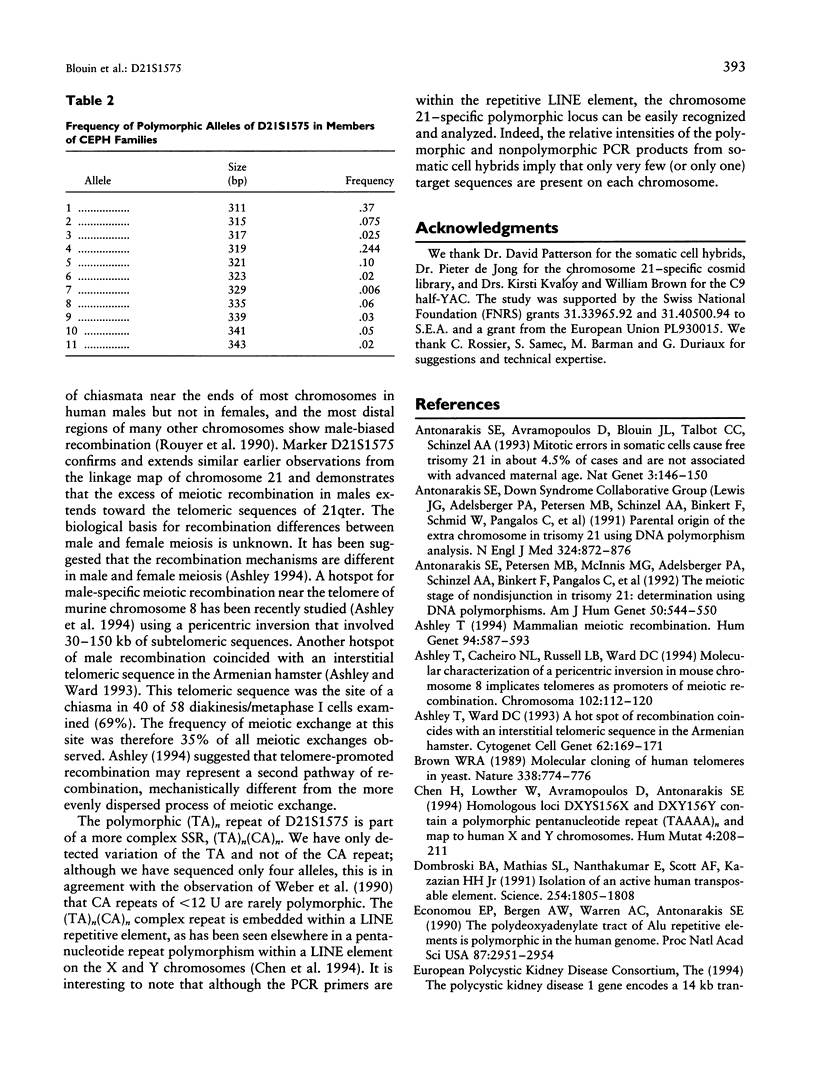
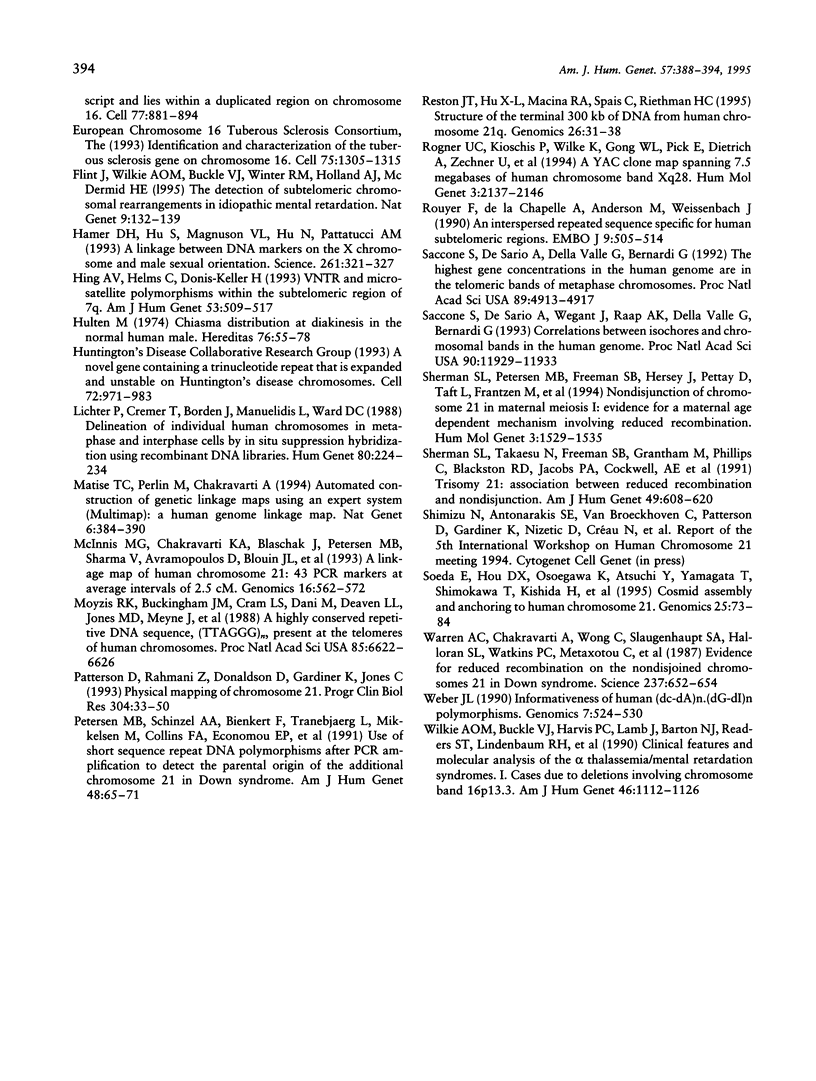
Images in this article
Selected References
These references are in PubMed. This may not be the complete list of references from this article.
- Antonarakis S. E., Avramopoulos D., Blouin J. L., Talbot C. C., Jr, Schinzel A. A. Mitotic errors in somatic cells cause trisomy 21 in about 4.5% of cases and are not associated with advanced maternal age. Nat Genet. 1993 Feb;3(2):146–150. doi: 10.1038/ng0293-146. [DOI] [PubMed] [Google Scholar]
- Antonarakis S. E., Petersen M. B., McInnis M. G., Adelsberger P. A., Schinzel A. A., Binkert F., Pangalos C., Raoul O., Slaugenhaupt S. A., Hafez M. The meiotic stage of nondisjunction in trisomy 21: determination by using DNA polymorphisms. Am J Hum Genet. 1992 Mar;50(3):544–550. [PMC free article] [PubMed] [Google Scholar]
- Ashley T., Cacheiro N. L., Russell L. B., Ward D. C. Molecular characterization of a pericentric inversion in mouse chromosome 8 implicates telomeres as promoters of meiotic recombination. Chromosoma. 1993 Jan;102(2):112–120. doi: 10.1007/BF00356028. [DOI] [PubMed] [Google Scholar]
- Ashley T. Mammalian meiotic recombination: a reexamination. Hum Genet. 1994 Dec;94(6):587–593. doi: 10.1007/BF00206950. [DOI] [PubMed] [Google Scholar]
- Ashley T., Ward D. C. A "hot spot" of recombination coincides with an interstitial telomeric sequence in the Armenian hamster. Cytogenet Cell Genet. 1993;62(2-3):169–171. doi: 10.1159/000133464. [DOI] [PubMed] [Google Scholar]
- Brown W. R. Molecular cloning of human telomeres in yeast. Nature. 1989 Apr 27;338(6218):774–776. doi: 10.1038/338774a0. [DOI] [PubMed] [Google Scholar]
- Chen H., Lowther W., Avramopoulos D., Antonarakis S. E. Homologous loci DXYS156X and DXYS156Y contain a polymorphic pentanucleotide repeat (TAAAA)n and map to human X and Y chromosomes. Hum Mutat. 1994;4(3):208–211. doi: 10.1002/humu.1380040306. [DOI] [PubMed] [Google Scholar]
- Dombroski B. A., Mathias S. L., Nanthakumar E., Scott A. F., Kazazian H. H., Jr Isolation of an active human transposable element. Science. 1991 Dec 20;254(5039):1805–1808. doi: 10.1126/science.1662412. [DOI] [PubMed] [Google Scholar]
- Economou E. P., Bergen A. W., Warren A. C., Antonarakis S. E. The polydeoxyadenylate tract of Alu repetitive elements is polymorphic in the human genome. Proc Natl Acad Sci U S A. 1990 Apr;87(8):2951–2954. doi: 10.1073/pnas.87.8.2951. [DOI] [PMC free article] [PubMed] [Google Scholar]
- Flint J., Wilkie A. O., Buckle V. J., Winter R. M., Holland A. J., McDermid H. E. The detection of subtelomeric chromosomal rearrangements in idiopathic mental retardation. Nat Genet. 1995 Feb;9(2):132–140. doi: 10.1038/ng0295-132. [DOI] [PubMed] [Google Scholar]
- Hamer D. H., Hu S., Magnuson V. L., Hu N., Pattatucci A. M. A linkage between DNA markers on the X chromosome and male sexual orientation. Science. 1993 Jul 16;261(5119):321–327. doi: 10.1126/science.8332896. [DOI] [PubMed] [Google Scholar]
- Hing A. V., Helms C., Donis-Keller H. VNTR and microsatellite polymorphisms within the subtelomeric region of 7q. Am J Hum Genet. 1993 Aug;53(2):509–517. [PMC free article] [PubMed] [Google Scholar]
- Hultén M. Chiasma distribution at diakinesis in the normal human male. Hereditas. 1974;76(1):55–78. doi: 10.1111/j.1601-5223.1974.tb01177.x. [DOI] [PubMed] [Google Scholar]
- Lichter P., Cremer T., Borden J., Manuelidis L., Ward D. C. Delineation of individual human chromosomes in metaphase and interphase cells by in situ suppression hybridization using recombinant DNA libraries. Hum Genet. 1988 Nov;80(3):224–234. doi: 10.1007/BF01790090. [DOI] [PubMed] [Google Scholar]
- Matise T. C., Perlin M., Chakravarti A. Automated construction of genetic linkage maps using an expert system (MultiMap): a human genome linkage map. Nat Genet. 1994 Apr;6(4):384–390. doi: 10.1038/ng0494-384. [DOI] [PubMed] [Google Scholar]
- McInnis M. G., Chakravarti A., Blaschak J., Petersen M. B., Sharma V., Avramopoulos D., Blouin J. L., König U., Brahe C., Matise T. C. A linkage map of human chromosome 21:43 PCR markers at average intervals of 2.5 cM. Genomics. 1993 Jun;16(3):562–571. doi: 10.1006/geno.1993.1231. [DOI] [PubMed] [Google Scholar]
- Moyzis R. K., Buckingham J. M., Cram L. S., Dani M., Deaven L. L., Jones M. D., Meyne J., Ratliff R. L., Wu J. R. A highly conserved repetitive DNA sequence, (TTAGGG)n, present at the telomeres of human chromosomes. Proc Natl Acad Sci U S A. 1988 Sep;85(18):6622–6626. doi: 10.1073/pnas.85.18.6622. [DOI] [PMC free article] [PubMed] [Google Scholar]
- Patterson D., Rahmani Z., Donaldson D., Gardiner K., Jones C. Physical mapping of chromosome 21. Prog Clin Biol Res. 1993;384:33–50. [PubMed] [Google Scholar]
- Petersen M. B., Schinzel A. A., Binkert F., Tranebjaerg L., Mikkelsen M., Collins F. A., Economou E. P., Antonarakis S. E. Use of short sequence repeat DNA polymorphisms after PCR amplification to detect the parental origin of the additional chromosome 21 in Down syndrome. Am J Hum Genet. 1991 Jan;48(1):65–71. [PMC free article] [PubMed] [Google Scholar]
- Reston J. T., Hu X. L., Macina R. A., Spais C., Riethman H. C. Structure of the terminal 300 kb of DNA from human chromosome 21q. Genomics. 1995 Mar 1;26(1):31–38. doi: 10.1016/0888-7543(95)80079-2. [DOI] [PubMed] [Google Scholar]
- Rogner U. C., Kioschis P., Wilke K., Gong W., Pick E., Dietrich A., Zechner U., Hameister H., Pragliola A., Herman G. E. A YAC clone map spanning 7.5 megabases of human chromosome band Xq28. Hum Mol Genet. 1994 Dec;3(12):2137–2146. doi: 10.1093/hmg/3.12.2137. [DOI] [PubMed] [Google Scholar]
- Rouyer F., de la Chapelle A., Andersson M., Weissenbach J. An interspersed repeated sequence specific for human subtelomeric regions. EMBO J. 1990 Feb;9(2):505–514. doi: 10.1002/j.1460-2075.1990.tb08137.x. [DOI] [PMC free article] [PubMed] [Google Scholar]
- Saccone S., De Sario A., Della Valle G., Bernardi G. The highest gene concentrations in the human genome are in telomeric bands of metaphase chromosomes. Proc Natl Acad Sci U S A. 1992 Jun 1;89(11):4913–4917. doi: 10.1073/pnas.89.11.4913. [DOI] [PMC free article] [PubMed] [Google Scholar]
- Saccone S., De Sario A., Wiegant J., Raap A. K., Della Valle G., Bernardi G. Correlations between isochores and chromosomal bands in the human genome. Proc Natl Acad Sci U S A. 1993 Dec 15;90(24):11929–11933. doi: 10.1073/pnas.90.24.11929. [DOI] [PMC free article] [PubMed] [Google Scholar]
- Sherman S. L., Petersen M. B., Freeman S. B., Hersey J., Pettay D., Taft L., Frantzen M., Mikkelsen M., Hassold T. J. Non-disjunction of chromosome 21 in maternal meiosis I: evidence for a maternal age-dependent mechanism involving reduced recombination. Hum Mol Genet. 1994 Sep;3(9):1529–1535. doi: 10.1093/hmg/3.9.1529. [DOI] [PubMed] [Google Scholar]
- Sherman S. L., Takaesu N., Freeman S. B., Grantham M., Phillips C., Blackston R. D., Jacobs P. A., Cockwell A. E., Freeman V., Uchida I. Trisomy 21: association between reduced recombination and nondisjunction. Am J Hum Genet. 1991 Sep;49(3):608–620. [PMC free article] [PubMed] [Google Scholar]
- Soeda E., Hou D. X., Osoegawa K., Atsuchi Y., Yamagata T., Shimokawa T., Kishida H., Soeda E., Okano S., Chumakov I. Cosmid assembly and anchoring to human chromosome 21. Genomics. 1995 Jan 1;25(1):73–84. doi: 10.1016/0888-7543(95)80111-x. [DOI] [PubMed] [Google Scholar]
- Warren A. C., Chakravarti A., Wong C., Slaugenhaupt S. A., Halloran S. L., Watkins P. C., Metaxotou C., Antonarakis S. E. Evidence for reduced recombination on the nondisjoined chromosomes 21 in Down syndrome. Science. 1987 Aug 7;237(4815):652–654. doi: 10.1126/science.2955519. [DOI] [PubMed] [Google Scholar]
- Weber J. L. Informativeness of human (dC-dA)n.(dG-dT)n polymorphisms. Genomics. 1990 Aug;7(4):524–530. doi: 10.1016/0888-7543(90)90195-z. [DOI] [PubMed] [Google Scholar]
- Wilkie A. O., Buckle V. J., Harris P. C., Lamb J., Barton N. J., Reeders S. T., Lindenbaum R. H., Nicholls R. D., Barrow M., Bethlenfalvay N. C. Clinical features and molecular analysis of the alpha thalassemia/mental retardation syndromes. I. Cases due to deletions involving chromosome band 16p13.3. Am J Hum Genet. 1990 Jun;46(6):1112–1126. [PMC free article] [PubMed] [Google Scholar]





